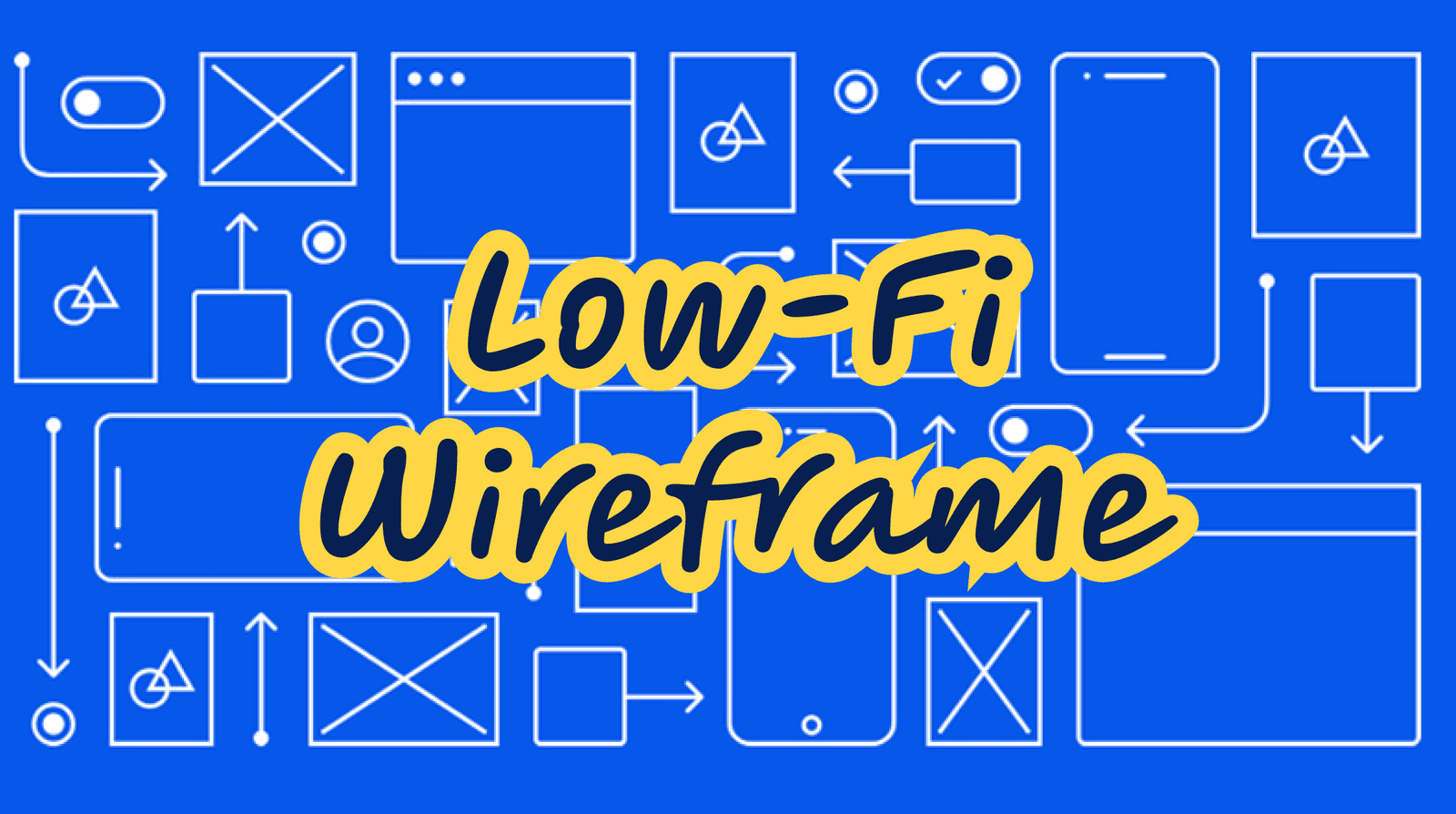Summary by AI ✦
What is the Low-Fidelity Wireframe?
Low-fidelity wireframes serve as fundamental blueprints for web pages or app screens, emphasizing the communication of the overall concept rather than intricate details, which is the realm of high-fidelity wireframes.
Think of them as akin to quick concept sketches on the back of a napkin, providing a rough layout to swiftly assess user solutions. Typically grayscale, these designs employbasic elements like shapes, image placeholders, and generic text to outline the layout. Screen segmentation into "zones" or "blocks" guides the placement of buttons, menus, images, text, and headings, with each screen taking only minutes to sketch.
These frames can be interconnected into a "wire flow" to depict navigational order. At the low-fidelity stage, precision regarding scale, grid conformity, or pixel perfection is unnecessary. They also serve to involve non-designers in shaping the product or service during early development stages, empowering both design and non-design teams alike.
How to create low-fidelity wireframe
Low-fidelity design tools prove invaluable for swift iterations, particularly during the initial phases of engineering design. They aid designers in shaping their foundational mental blueprint for the layout and navigational framework.To expedite the visualization of numerous initial concepts, designers often include only basic drawing functionalities in their tools. This approach fosters creativity and instills the notion that ideas are abundant and transient.
Tools to create low-fidelity wireframe
1. Pencil & Paper: Pencil & paper is still the preferred tool for brainstorming and ideation. We started using pen & paper for designing my wireframes precisely at the same time as the market for wireframing app started booming.
Choosing pen & paper over a sexy app can seem like a strange choice. Especially in such exciting times, right? Well, not really. The idea is to put whatever is going on inside, you put it on paper quickly without much given a thoughts.
2. Balsamiq: Balsamiq Wireframes is a rapid low-fidelity UI wireframing tool that reproduces the experience of sketching on a notepad or whiteboard, but using a computer.
It really forces you to focus on structure and content, avoiding lengthy discussions about colors and details that should come later in the process.
4. Miro: Miro Wireframe is a great tool to visualize the skeletal frame of your website and applications, find issues, and improve the design to offer a better user experience.
In modern designs, visualization has become crucial. It’s an advanced way of seeing what elements you need in your designs and how it looks in real-time.
You can learn more about app wireframing with Miro.
3. FigJam: FigJam empowers teams to build better products, together. Define ideas, align on decisions, and move work forward—all in one place.
Template is available to quick start. Access Figma Figjam template here.
Step-by-step guide to create Low-fi wireframes
Low-fidelity design tools prove invaluable for swift iterations, particularly during the initial phases of design. They aid designers in shaping their foundational mental blueprint for the layout and navigational framework.
To expedite the visualization of numerous initial concepts, designers often include only basic drawing functionalities in their tools. This approach fosters creativity and instills the notion that ideas are abundant and transient.
1. Define objectives: Clearly outline the goals and functionalities of the interface or design you're wireframing. Understand the user needs and the key features you want to include.
2. Gather materials: Grab a few sheets of plain paper (preferably larger size for ease of sketching), a sharpened pencil or pen, and an eraser. You may also want to have a ruler handy for straight lines if needed.
3. Sketch the basic: Start by drawing a rough outline of the screen or page you're designing for. This could be a simple rectangle representing a website page, mobile app screen, or any other interface.
4. Block out core elements: Use basic shapes and lines to block out the major components of your design. This might include placeholders for navigation menus, content areas, buttons, forms, etc. Focus on overall structure and placement rather than details.
5. Add content and details: Once you have the basic layout, start adding content and details to your wireframe. Use simple labels or placeholders to indicate text, images, buttons, and other elements. Keep it simple and avoid getting bogged down in specifics.
6. Iterate and refine: As you work through your wireframe, don't be afraid to iterate and refine your ideas. Erase and redraw elements as needed, and experiment with different layouts and arrangements. The goal is to explore multiple design options quickly and efficiently.
7. Test to gather feedback: Once you have a basic wireframe, consider sharing it with others for feedback. This could be colleagues, stakeholders, or potential users. Use their input to make improvements and refinements to your design.
8. Finalize your wireframe: Once you're satisfied with your wireframe and have incorporated feedback, you can create a cleaner, more polished version if needed. This could involve transferring your sketch to digital format using wireframing software or refining it further by hand.
Remember, the key advantage of low-fidelity wireframing with pencil and paper is speed and flexibility. Don't worry about making things perfect—focus on quickly capturing and iterating on your ideas to move the design process forward.
"Low-fidelity wireframing helps you to iterating and develop your ideas to move the design process forward."
Why are low-fidelity wireframes important?
You might be wondering why you should use a low-fidelity wireframe. Why don’t you just go straight to high-fidelity? There are a few reasons why using a low-fi wireframes first can be beneficial. Let’s have a look:
• It gets the ball rolling. If you have to wait to get a developer involved, creating your new website or app can take a while. But using low-fi wireframes you can start creating without needing intricate technical detail.
• Identify areas of improvement. With a low-fi structure, it’s easier to spot bigger issues. There isn’t as much detail, so you can see from the top level where the gaps are. Using a low-fi template first also means it’s easy to make changes before things get too technical and harder to change.
• Create a solid foundation. Low-fi wireframes give you a solid foundation to build on. If you don’t have a solid starting point, your future wireframes will be built on an unstable foundation.
• Easily share the blueprints. Low-fidelity wireframes are easier to understand. This means you can share basic technical information with key stakeholders who might not have technical knowledge.
• Although high-fidelity wireframes provide more detail and user-testing capabilities, it’s important to create a solid foundation with a low-fi structure first.
When to use a low-fidelity wireframe
Sequential low-fidelity wireframes are quick, easy representations and a great way to explain an initial idea to your team, clients, or stakeholders.You can use low-fidelity wireframes in the early stages of design, such as:
• Meetings or workshops to turn your team’s ideas into visual sketches
• Presentations, to quickly share several product ideas in development
• Information architecture phases of product development to focus on user flows
• Critique sessions for honest, actionable feedback or direction on rough work
Exploring concepts as early as possible safeguards your team against last-minute changes or expensive setbacks and also enables you to improve and refine your product. Your team can consider different ways of approaching a problem and encourage everyone’s voice to be heard.
Hire low-fidelity wireframe expert
We understand that it is challenging to creating digital wireframes to define user experiences and gather team feedback. Don’t worry, Sketchish can help you to build the digital product experience from ideas to launch. Our expert UX team can help you to create low-fidelity prototypes early in the product design process and iterate rapidly as the project evolves. Once you’ve got buy-in, take your design to high-fidelity. No matter where you are in the design process, Sketchish team is there to help.
Related case study to understand better our process and outcome.
Share on:



